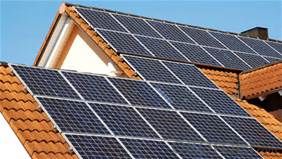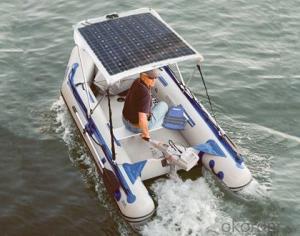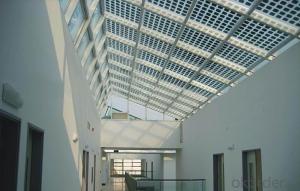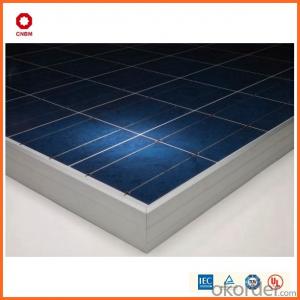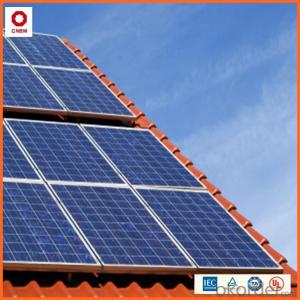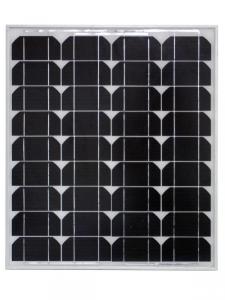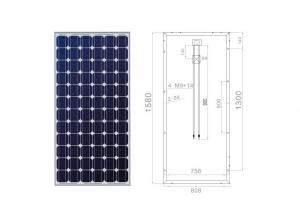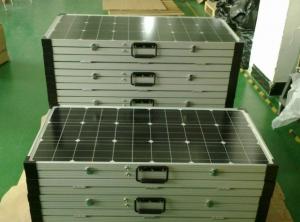Flexible Solar Panels Kit for RV - 180W Patrol Car Solar Panels
- Loading Port:
- China main port
- Payment Terms:
- TT OR LC
- Min Order Qty:
- 100 watt
- Supply Capability:
- 100000000 watt/month
OKorder Service Pledge
OKorder Financial Service
You Might Also Like
Specification
Highest Efficiency Solar Panel 20w 50w 100W 120W Flexible Solar Panels, Boat Flexible Solar Panels
High efficiency bendable solar module adopts the highest efficiency cell in the world from USA, with efficiency up to 20% or highter,which enable 25-30% higher power generation than the conventional PV modules at the same size..
By adopting the back contact technique,the cell can be coated with the flexible materials and finally forms the high efficiency flexible solar panel.this kind of solar panel can be widely used in the field of Electric Golf Car,Patrol Car,Travel Tourism Car,Yacht,Roof Power generation,Backpack,Tent and so on.


Features of our products:
• High conversion efficiency mono/poly-crystalline amorphous silicon solar cells
• Modules incorporate high performance bypass diodes to minimize the power drop caused by shading
• High transmittance, low-iron tempered glass
• High performance EVA encapsulant to prevent destroying and water.
• AI frame: without screw, corner connection. 8 holes on the frame can be installed easily
• Good performance of preventing from atrocious weather such as wind and hails
• Certifications: CE IEC TUV VDE UL, Class I
• 10 years 90% power output warranty
As a professional Solar Panel manufacturer and Supplier in China, we have our customers come around the whole world and our specialization has got a worldwide recognition. Meanwhile, with our superior quality, competitive price, prompt and excellent service, As main role in trade section of CNBM Group, CNBM International Corporation supplies products including Monocrystalline Solar Panel, Polycrystalline Solar Panel ( multicrystalline silicon Solar Panel) have received and enjoyed famous reputation in many countries and regions in the world.
China National Building Material Group Corporation
CNBM International Corporation is a professional solar panel manufacturer in China for CNBM brand . Silicon panel ( silicon module), as our main product, has high quality and good service. Our products are very popular in Europe, Australia, England, Middle East, Mexico, Argentina, Chili, Singapore and Africa.
Furthermore, our products have gained international authorized certificates like TUV, UL and CE.
China National Building Material (Group) Corporation (CNBM), established in 1984, is one of the largest State-owned group corporations of building & mechanical materials which specializes in the design, manufacturing and distribution of building materials in the world.
As the whole world turns “green”, CNBM enters into the Photovoltaic Industry in 2005.After 6 years' fast growth, now our annual capacity is 500MW solar panel and 500MW solar cell.
- Q: How can solar panels be integrated into building designs?
- Solar panels can be integrated into building designs by incorporating them into the roof or facade of the building. This involves installing solar panels in a way that seamlessly blends with the architecture while maximizing exposure to sunlight. Additionally, solar panels can also be integrated into shading devices, windows, or canopies to generate electricity while providing additional functions such as shading or daylighting.
- Q: Does anyone know how I would go about hooking up the air conditioners in my house to solar panels? I would want just the air conditioners to be powered by solar energy. How could I hook it up where the panels can absorb energy from the sun during the day, and save and store the energy so I can run the air conditioners at night? I really feel that in the long run, this would save a lot of money with the energy bill. It's the use of the air conditioners that drive up the bill. Is this idea feasible? Is it also possible to have some sort of hybrid system where I can switch from solar to my regular local energy source when I want to?
- There's no need to connect only the A/C to solar, nor is there a need to use batteries. Both of those problems are solved with grid-tied solar. The solar electricity system works alongside your regular, and the A/C just plugs in normally. You never need to worry about switching. During the day, if the A/C is drawing power, the solar goes into that, reducing your draw from the electric company. If the solar generates more than the A/C needs, the meter is driven backwards. At night, the meter runs forward again. For example, the meter may read 5000 in the morning. By evening, maybe it reads 4975. At night, it creeps back up to 5005. When the meter reader comes, you would be billed for only 5 kWh. That's the general idea. Also, consider whether you can insulate your home more, and whether you might want to change out your air conditioners for new, DC inverter mini-split units. Those can use a fraction of the electricity per BTU of regular air conditioners.
- Q: looking for a solar panel to charge my laptop on the road, macbook is 60 watt 6.v 3.5a, what should i be looking for in a solar panel?
- Well that's a good idea,,,here's what ya need..First you need an array that will overcome the drain effect created by the in use or sleeping laptop...that is best solved by averaging out the real use of the machine in terms of watt/minutes...If you check your transformer you'll see it has a capacity which you have cited however the true use of the computer is about 40-50 percent of that in watt/minutes..but only while your using it and when in the sleep mode the watt/minute value drops even more to about 5%.... So if your actual use consists of 2 hours of use per day at 50% and 2 hours at 5% percent the actual wattage draw is only averaged out at 34watts/minute. optimally your panel should supply all your power from its photovoltaic conversion ,but in the real world application the panel only recharges ,over a period of time, the used power. So if you had a 5 watt (@ 2vdc) panel working 480 minutes and used up 35 x2=700 and 9 x2=8 for a total of 78 watts you would have 5 x 480 = 7200 watts input and a parasitic load of 78 watts in the two hours...well within the recharge state required.. For a little safety I would permanently wire a cigarette lighter type plug to the end of the panel this will keep the polarity correct and serve as a quick disconnet means...Also add a fuse at .5 amp... a good place to get these are on the internet....some are very expensive some a very cheap --go for a middle of the roader...Have a good one from the E...
- Q: im aware i dont fully understand. but with what i do. if P = iv, and current changes with voltage, whats the point of changing either. if in any cicumstance, you end up with the same wattage, how does changing either effect a solar setup. (2v panel vs 24v)thanks in advance. explain in laymans if you can.
- The choice of solar panel voltage comes down more to what the panels will be connected to. You're right that power can remain the same at the different voltages. Higher input (panel) voltages are sometimes used in inverter systems to reduce the effect of voltage draw-down. 2v panels (about 20v open circuit) work well for charging 2v batteries, connected in parallel, through a charge controller. For use of a grid-tie inverter, higher input voltages are sometimes used to reduce the effects of draw-down. You want to select and wire (parallel vs. series) your panels based on the input voltage requirement of the load, whatever it may be.
- Q: Are solar panels affected by temperature?
- Yes, solar panels are affected by temperature. Higher temperatures can decrease the efficiency of solar panels, causing a decrease in their power output.
- Q: I have heard you can make your own solar panels.... But How?Where do you start? Is it cheap, or should I just BUY them already made?
- Well, I can think of a couple places, that you might have got that info from. There are several plans on the net. to build solar heaters from auxillary window units, to full thermal mass walls, with stacked 55 gallon barrels painted flat black, and filled with water. Old Mother Earth News magazines are a great source for these, but its basically sittin a closed box in the sun. . . Not very sexy, and not exactly Rocket Science, I'm thinkin what your askin about is Photovoltaics. Basically a reaction in a silicon chip, that pushes an electron toward the grid. Electiricty producing solar panels, are beyond the capabilities of a single person, however, they''re are (or were a couple months ago). a couple retail sales OKorder stores, scavaging they''re broken panels, cutting out the individual single cells, and then selling them as kits, with instructions how to wire, solder and assmeble working cells. Thats probably what your hearing about, and I think they ended up being about /2 price what they''re new ones sell for. Then you can move on to the bottlemeck problem, that all the green alternative ideas run into . . .How to store it Good luck, and Good Hunting . . Tim
- Q: Why are they placed there? How come they aren't placed on the floor or window.My fiance and I are interested in putting solar panels on our new home. I was really curious and google wasn't giving me the answer. My roof is pretty small in our new house and I don't think it would fit there. Why is it usually placed there and is there another place? You will be chosen as best answer if you answer all my questions. Thanks in advance, and I would appreciate if nobody is rude. Otherwise, I will have to report abuse.
- The roof is the most popular location for panels, I'd imagine because: ) The space is not otherwise being used. Panels in the yard would take up play space, or shade the garden or lawn. 2) The roof is usually more free from shadows because it's high up. Something low to the ground could more easily be shaded by trees, fences, or nearby buildings. 3) The roof often has a built-in tilt that is more ideal for panels. Take a good look at your roof, especially if there is a south-facing side. The roof could be bigger than you think. Only 0% of our roof area is dedicated to solar panels, and that keeps up with our yearly electrical usage.
- Q: Is it as simple as buying the panels, an inverter and plugging it into a wall-socket, assuming it would just send power back into the outlet and supplement my house's electrical usage, or... Is it not that simple?Remember, I'm talking about a SMALL system, and I don't care how little power it'd make, or how uneconomical it would be.
- If I were to assume you could (and I don't) you'd be back feeding voltage into your breaker and probably ruin it. Or worse, start a fire somewhere on that circuit. Not to mention the need to match the Hertz AND the signal. Short answer is No, you can't do that. Not because of code - but code wouldn't allow it anyway, but because it is foolish and beyond dangerous - it's a guaranteed disaster. Hope this helps. ??? —
- Q: Can solar panels be installed on a tennis court or sports complex?
- Yes, solar panels can be installed on a tennis court or sports complex. These areas often have large open spaces with ample sunlight, making them ideal for solar panel installations. Additionally, integrating solar panels into sports facilities can help offset energy costs and promote sustainability.
Send your message to us
Flexible Solar Panels Kit for RV - 180W Patrol Car Solar Panels
- Loading Port:
- China main port
- Payment Terms:
- TT OR LC
- Min Order Qty:
- 100 watt
- Supply Capability:
- 100000000 watt/month
OKorder Service Pledge
OKorder Financial Service
Similar products
Hot products
Hot Searches
Related keywords




